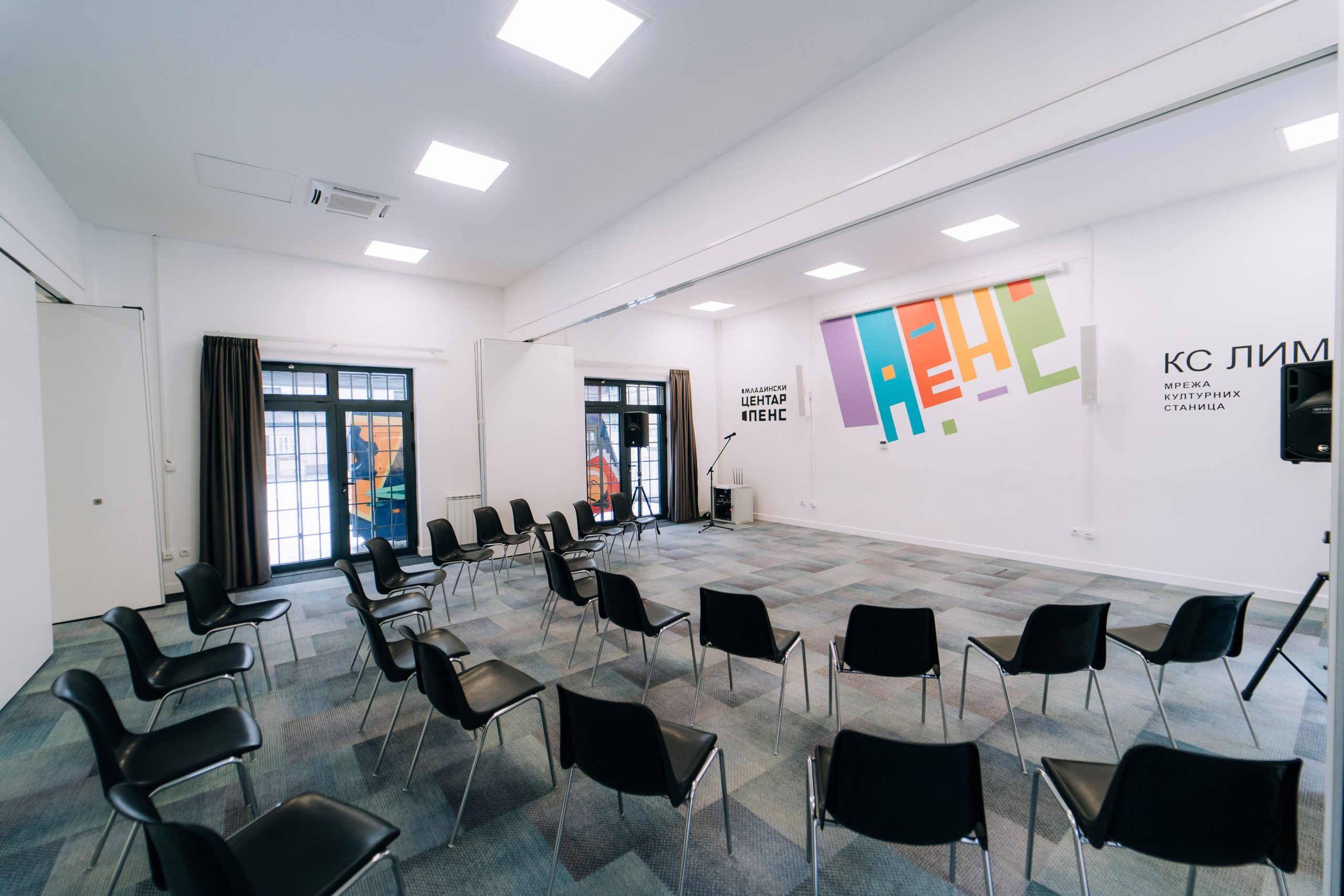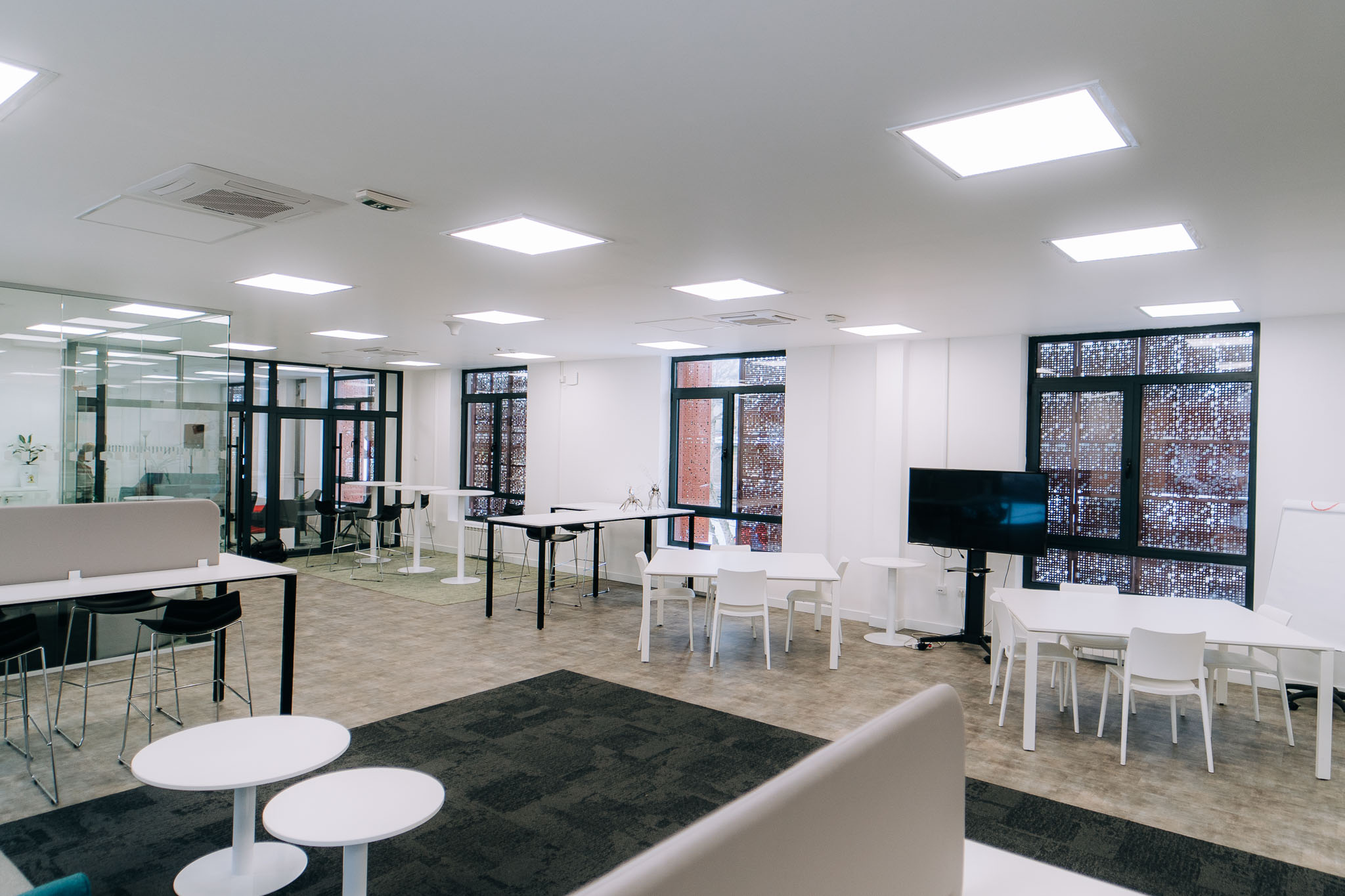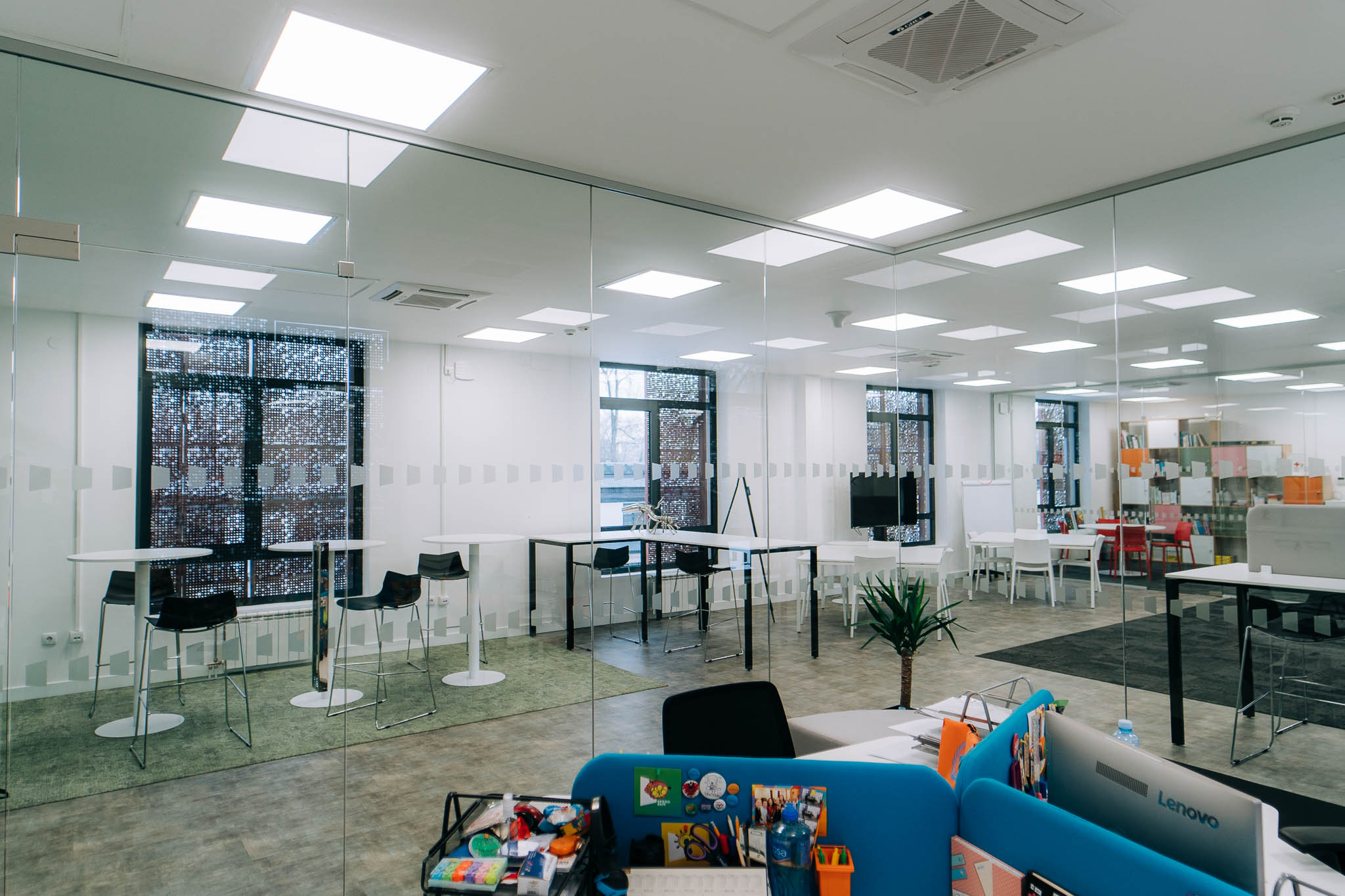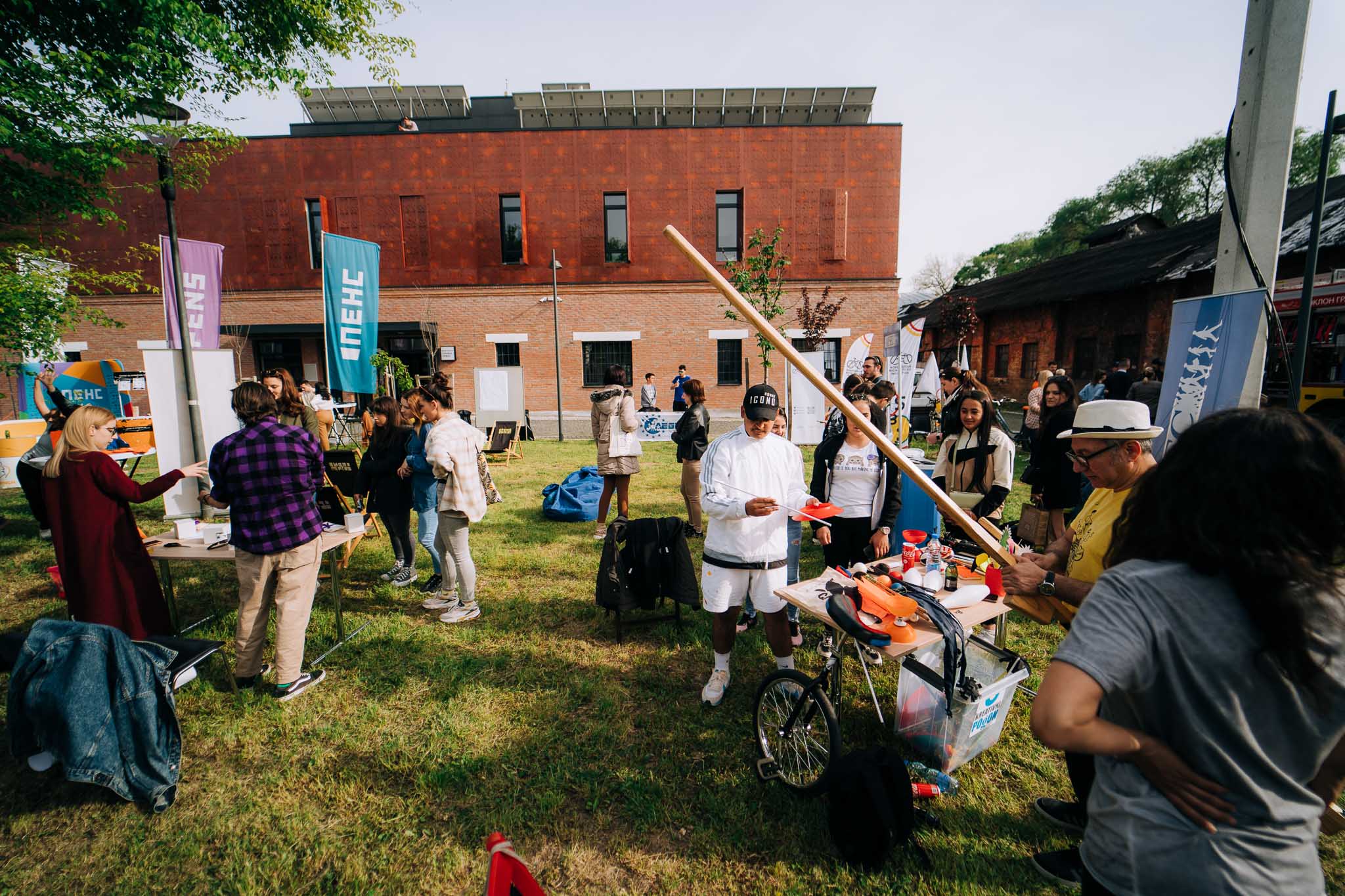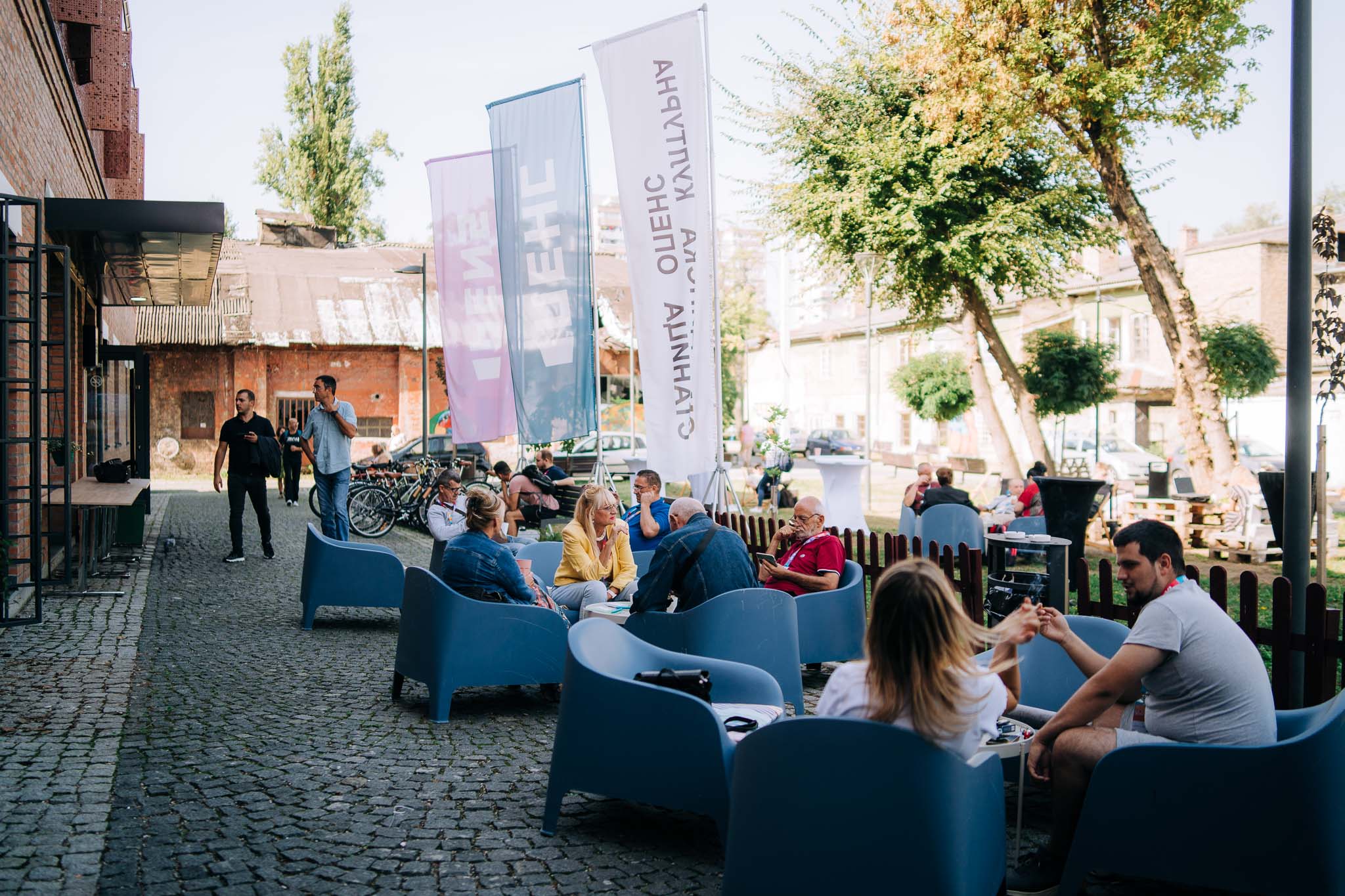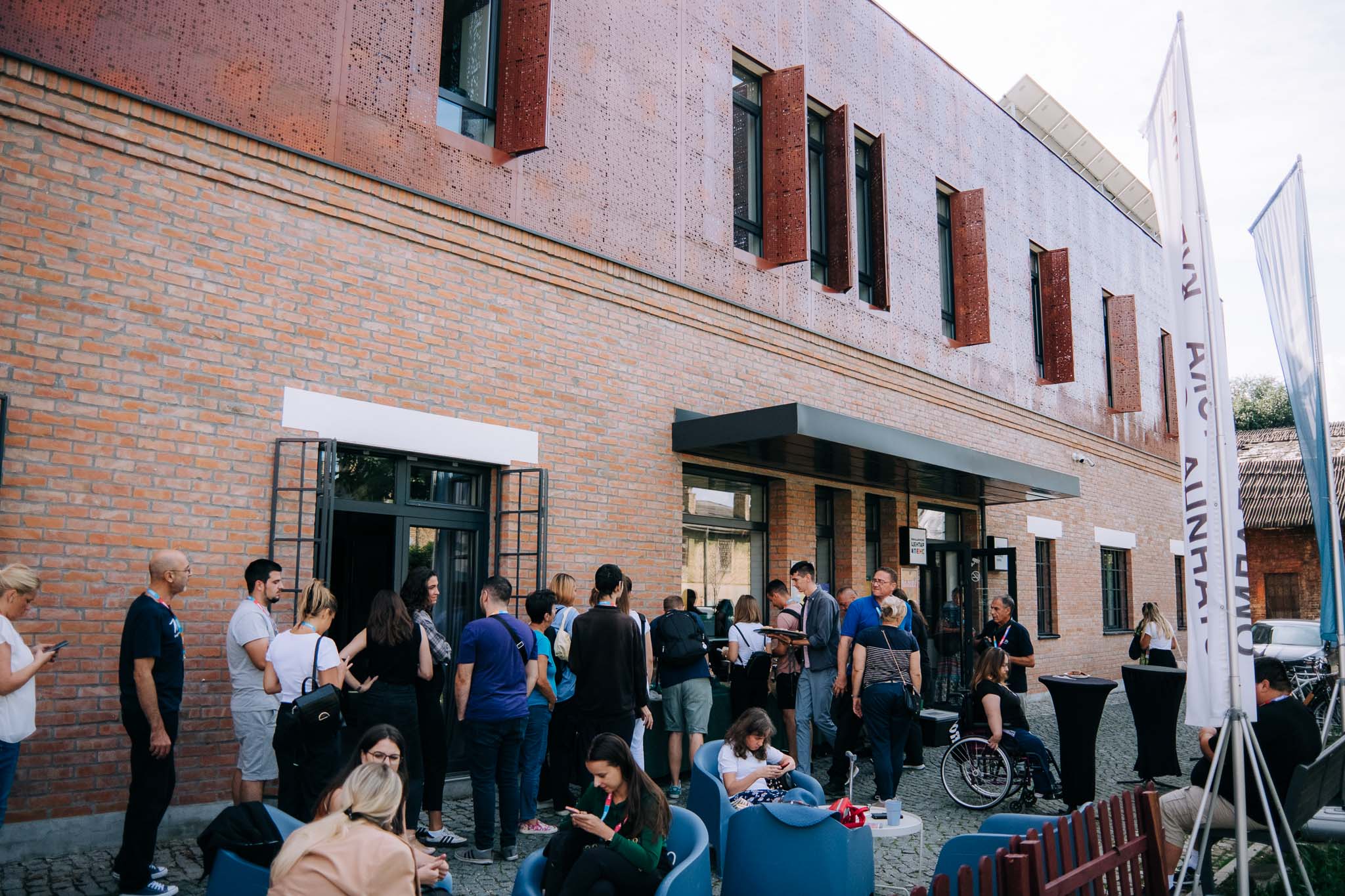Regaining a sense of belonging
The OPENS Youth Center
The OPENS Youth Center
The OPENS Youth Center is a dynamic, sustainable urban regeneration project that transformed the Petar Drapšin factory in Novi Sad into a vibrant cultural hub for youth. With solar panels, waste sorting, and historic preservation, it blends green energy and inclusivity. The center offers services like an Innovation Hub, Mental Health Club, and Job Info Center, empowering youth through engagement, support, and opportunities.
Serbia
Local
Novi Sad
Mainly urban
It refers to a physical transformation of the built environment (hard investment)
Yes
2021-08-12
No
No
No
As a representative of an organisation
The OPENS Youth Center represents an innovative and sustainable urban regeneration project that transformed the former Petar Drapšin factory in Novi Sad into a vibrant, youth-focused cultural hub. The project aimed to reduce carbon footprints through adaptive reuse of the existing industrial structure, integrating renewable energy, circular economy practices, and inclusive design. Key sustainable features include solar panels, waste sorting bins, and the preservation of the building’s historical elements. It fosters a green, energy-efficient space where youth can engage in various activities such as workshops, performances, and networking.
Targeting primarily youth, the center is accessible, inclusive, and adaptable, offering services like a Mental Health Club, Innovation Hub, Youth Club, Job Info Center, and EU Info Corner. The project engaged local communities in the planning phase through public discussions, ensuring the center reflects their needs and aspirations. The governance model is participatory, with youth directly involved in decision-making. OPENS also addresses challenges such as youth unemployment, mental health issues, and social exclusion by providing resources, support, and job opportunities.
The successful transformation serves as a replicable model for other urban spaces and has led to national and international recognition, including Novi Sad being named European Youth Capital in 2019. OPENS is a beacon of inclusivity, sustainability, and youth empowerment, demonstrating how adaptive reuse can blend historical preservation with modern innovation.
Targeting primarily youth, the center is accessible, inclusive, and adaptable, offering services like a Mental Health Club, Innovation Hub, Youth Club, Job Info Center, and EU Info Corner. The project engaged local communities in the planning phase through public discussions, ensuring the center reflects their needs and aspirations. The governance model is participatory, with youth directly involved in decision-making. OPENS also addresses challenges such as youth unemployment, mental health issues, and social exclusion by providing resources, support, and job opportunities.
The successful transformation serves as a replicable model for other urban spaces and has led to national and international recognition, including Novi Sad being named European Youth Capital in 2019. OPENS is a beacon of inclusivity, sustainability, and youth empowerment, demonstrating how adaptive reuse can blend historical preservation with modern innovation.
Sustainability
Inclusivity
Urban Regeneration
Youth Empowerment
Circular Economy
The adaptation of an old factory building into a youth center significantly reduces the carbon footprint by preserving existing structures instead of new construction, aligning with sustainable urban development principles. The installation of solar panels ensures the use of renewable energy, reducing dependence on fossil fuels and lowering greenhouse gas emissions. The project promotes a circular economy by repurposing industrial heritage, minimizing construction waste, and extending the lifecycle of existing materials. Additionally, bins for sorting recyclable waste encourage responsible waste management, promoting recycling and resource efficiency within the community. By revitalizing a former industrial space with sustainable infrastructure and energy-efficient solutions, the project actively contributes to reducing pollution. The integration of clean energy and waste reduction practices minimizes environmental impact while fostering eco-friendly behavior among youth and visitors. This project serves as a replicable model for sustainable urban regeneration, demonstrating how industrial heritage can be transformed into an energy-efficient, low-waste, and community-driven space. By integrating renewable energy, circular economy principles, and waste reduction, the youth center exemplifies how adaptive reuse can align with European Green Deal objectives and inspire future sustainable developments.
The OPENS Youth Center masterfully balances historical preservation with contemporary architectural solutions. By retaining key industrial elements, such as exposed brick, steel structures, and large open spaces, while integrating modern materials and sleek finishes, the design creates an inspiring and dynamic environment. This fusion of old and new respects Novi Sad’s industrial past while embracing its future as a cultural hub. The center is designed to be flexible and multifunctional, catering to a variety of youth activities, including workshops, performances, and discussions. The large conference hall, equipped with cutting-edge technology, enhances the usability of the space, making it an ideal venue for creative and educational events. Open, well-lit spaces foster collaboration and engagement, enhancing the overall experience for visitors. By transforming a former industrial site into a youth-focused center, the project empowers the local community and strengthens Novi Sad’s identity as a city of innovation. It provides a space where young people can express creativity, develop skills, and engage in cultural dialogue, reinforcing the city's legacy as a European Capital of Culture and European Youth Capital. The OPENS Youth Center serves as a model for repurposing abandoned industrial spaces into vibrant cultural landmarks. By preserving historical elements while embracing modern design and multifunctionality, the project demonstrates how thoughtful urban regeneration can create spaces that are both aesthetically appealing and deeply meaningful for the community.
OPENS Youth Center exemplifies inclusion through its commitment to accessibility, diversity, and participatory governance. It fosters an open and welcoming environment where everyone—regardless of physical ability, gender, or socio-economic background—can actively participate, contribute, and thrive. The center is fully accessible to wheelchair users, featuring flat floors, accessible restrooms, and an installed lift, despite having only two floors. These elements ensure that mobility-impaired individuals can navigate the space effortlessly, embodying the "design for all" principle and setting an example for inclusive architecture in cultural spaces. By offering weekend jobs for students, the center provides young people with economic opportunities that support their education and development. Additionally, employment policies promote diversity, actively hiring people with disabilities, members of the LGBTQ+ community, and women, ensuring equal opportunities in the workforce. The center’s majority-female team demonstrates a commitment to gender equity, serving as a model for inclusive employment practices. The governance model of OPENS is highly participatory, allowing young users of the space to be directly involved in program development and decision-making. This ensures that the center reflects the real needs and aspirations of its community, making it a dynamic and adaptable hub. By integrating physical accessibility, diverse employment policies, economic inclusion, and participatory governance, OPENS Youth Center serves as a beacon of inclusivity. It demonstrates how cultural and community spaces can break barriers, promote equality, and empower individuals, setting a new standard for inclusive urban development.
During the transformation of the old Petar Drapšin factory into the Creative District, citizens played a crucial role in the planning phase. Through public plenums and discussions, residents were informed about the reconstruction plans and given the opportunity to express their opinions, needs, and concerns. This bottom-up approach ensured that the final design reflected the expectations of both young people and the broader community. As the primary target group, youth are not just passive beneficiaries but active contributors to the center’s development and programming. The center provides essential services such as:
● Mental Health Club – Offering counseling and support programs for emotional well-being.
● Innovation Hub – A space for young entrepreneurs and creatives to develop projects and network.
● Youth Club – A safe and social gathering place for cultural and educational activities.
● Job Info Center – Helping young people navigate the job market and enhance employability.
● EU Info Corner – Providing resources and guidance on mobility, education, and funding opportunities within the EU.
By integrating citizens and young people into decision-making and program development, OPENS has created a truly community-driven space. This involvement has led to:
● A more inclusive and relevant cultural and social hub.
● Increased sense of ownership among young people and residents.
● Strengthened relationships between civil society, local authorities, and youth organizations.
By bridging cultural heritage with youth innovation, OPENS serves as a model of participatory urban transformation, demonstrating how collaborative planning can result in vibrant, sustainable, and youth-friendly public spaces.
● Mental Health Club – Offering counseling and support programs for emotional well-being.
● Innovation Hub – A space for young entrepreneurs and creatives to develop projects and network.
● Youth Club – A safe and social gathering place for cultural and educational activities.
● Job Info Center – Helping young people navigate the job market and enhance employability.
● EU Info Corner – Providing resources and guidance on mobility, education, and funding opportunities within the EU.
By integrating citizens and young people into decision-making and program development, OPENS has created a truly community-driven space. This involvement has led to:
● A more inclusive and relevant cultural and social hub.
● Increased sense of ownership among young people and residents.
● Strengthened relationships between civil society, local authorities, and youth organizations.
By bridging cultural heritage with youth innovation, OPENS serves as a model of participatory urban transformation, demonstrating how collaborative planning can result in vibrant, sustainable, and youth-friendly public spaces.
Youth Center OPENS is the outcome of collaboration between local, national, and European stakeholders, each playing a role in its design, funding, and execution. Their involvement has ensured the project’s sustainability, visibility, and replicability. The City of Novi Sad was instrumental in initiating the transformation of the former Petar Drapšin factory into the Creative District, allocating the budget and providing institutional support in alignment with local urban and youth policies. OPENS, a youth-led network, played a key role in shaping the concept of the new space, ensuring it would meet the needs of young people. The renovated building now serves as a Youth Center, with OPENS continuing to manage the space and develop programs, ensuring its long-term viability. Our expertise in youth engagement helped connect institutional support with grassroots needs. Recognizing the project’s potential, the Government of Serbia granted it national significance, leading to similar youth centers being replicated in Niš, Subotica, Sombor, and Novi Pazar. This model has become a blueprint for youth empowerment across Serbia. In 2019, the European Youth Forum recognized the commitment of OPENS and Novi Sad to youth participation by awarding the city the title of European Youth Capital. This accolade elevated the project’s European visibility and facilitated international partnerships, positioning Novi Sad as a leader in youth-centered urban development. The project’s success is due to:
• Institutional backing (local/national funding and policy integration)
• Youth-driven governance (ensuring the space meets youth needs)
• Scalability and national impact (replication across Serbia)
• European recognition and networking (boosting international partnerships) Through this collaboration, OPENS has become a model for youth participation and urban revitalization, combining policy support, grassroots activism, and European recognition into a sustainable, impactful initiative.
• Institutional backing (local/national funding and policy integration)
• Youth-driven governance (ensuring the space meets youth needs)
• Scalability and national impact (replication across Serbia)
• European recognition and networking (boosting international partnerships) Through this collaboration, OPENS has become a model for youth participation and urban revitalization, combining policy support, grassroots activism, and European recognition into a sustainable, impactful initiative.
The transformation of the former factory into the Creative District and the development of Youth Center OPENS combined multiple disciplines, creating an internationally influenced, yet locally rooted process. The collaboration among local decision-makers, architects, civil society, and young people worldwide enriched both the conceptual and physical development of the project.
Urban Planning & Architecture: Local architects and student architects from around the world, played a key role in reimagining the space. Their input helped preserve the site's historical authenticity while incorporating modern urban needs.
Participatory Urbanism & Civil Society: Citizens and civil society organizations co-created the district's vision through public discussions and planning sessions, ensuring a community-centered approach.
Local Governance & Policy-Making: The City of Novi Sad made significant political and financial commitments to revitalize the area, ensuring it would remain accessible and beneficial to the local community.
International Academic and Cultural Exchange: Architecture students from Bolivia, Syria, Sweden, and Brooklyn brought new perspectives, proving that urban transformation can blend local roots with global inspiration.
Youth Engagement & Cultural Programming: OPENS and youth organizations shaped the space’s functions, ensuring it serves as a hub for education, innovation, and cultural activities.
This dynamic approach to urban regeneration was made possible by integrating global academic expertise with local knowledge. Key achievements include:
International students provided fresh, objective insights while respecting the district’s history.
Public engagement ensured citizens’ needs were reflected in the final design.
Over 90% of the original structure was preserved, balancing heritage conservation with modern use.
The exchange between New York and Novi Sad boosted international visibility, positioning the city as a progressive cultural hub.
Urban Planning & Architecture: Local architects and student architects from around the world, played a key role in reimagining the space. Their input helped preserve the site's historical authenticity while incorporating modern urban needs.
Participatory Urbanism & Civil Society: Citizens and civil society organizations co-created the district's vision through public discussions and planning sessions, ensuring a community-centered approach.
Local Governance & Policy-Making: The City of Novi Sad made significant political and financial commitments to revitalize the area, ensuring it would remain accessible and beneficial to the local community.
International Academic and Cultural Exchange: Architecture students from Bolivia, Syria, Sweden, and Brooklyn brought new perspectives, proving that urban transformation can blend local roots with global inspiration.
Youth Engagement & Cultural Programming: OPENS and youth organizations shaped the space’s functions, ensuring it serves as a hub for education, innovation, and cultural activities.
This dynamic approach to urban regeneration was made possible by integrating global academic expertise with local knowledge. Key achievements include:
International students provided fresh, objective insights while respecting the district’s history.
Public engagement ensured citizens’ needs were reflected in the final design.
Over 90% of the original structure was preserved, balancing heritage conservation with modern use.
The exchange between New York and Novi Sad boosted international visibility, positioning the city as a progressive cultural hub.
Unlike many urban renewal projects that transform old industrial spaces into commercial or luxury real estate, this initiative prioritizes young people as the primary users. The process involved youth organizations in shaping the function and governance of the OPENS Youth Centre, ensuring it serves as an inclusive, accessible, and dynamic hub. The project engaged citizens in decision-making through public assemblies and consultations, a rare practice in top-down urban planning approaches. The inclusion of civil society organizations and youth-led governance ensures that the space remains a public good, rather than a privatized area. Student architects from around the world contributed fresh, diverse ideas that preserved over 90% of the original structures while ensuring functionality. This global-local exchange made Novi Sad’s urban regeneration process internationally relevant, setting a precedent for participatory design. While many revitalization projects superficially integrate sustainability elements, OPENS Youth Centre incorporates tangible, measurable green solutions:
● Solar panels provide renewable energy.
● Recycling stations encourage circular economy practices.
● Architectural preservation minimizes demolition waste.
The center is designed according to universal accessibility principles, with features such as ramps, adapted restrooms, and an elevator despite being a two-story building. The employment model prioritizes inclusivity, ensuring job opportunities for people with disabilities, LGBTQ+ individuals, and women. A flexible work structure offers weekend jobs for students, making it one of the few spaces that integrate youth employment into its operational model. This initiative sets a new standard for how cities can transform heritage spaces into sustainable, community-led cultural hubs. Its innovative governance, inclusivity, and sustainability practices make it a best-practice model for youth-centered urban regeneration across Europe.
● Solar panels provide renewable energy.
● Recycling stations encourage circular economy practices.
● Architectural preservation minimizes demolition waste.
The center is designed according to universal accessibility principles, with features such as ramps, adapted restrooms, and an elevator despite being a two-story building. The employment model prioritizes inclusivity, ensuring job opportunities for people with disabilities, LGBTQ+ individuals, and women. A flexible work structure offers weekend jobs for students, making it one of the few spaces that integrate youth employment into its operational model. This initiative sets a new standard for how cities can transform heritage spaces into sustainable, community-led cultural hubs. Its innovative governance, inclusivity, and sustainability practices make it a best-practice model for youth-centered urban regeneration across Europe.
The Creative District in Novi Sad and OPENS Youth Centre were developed through a multidisciplinary, participatory, and research-driven approach that ensured sustainability, inclusivity, and community relevance. The project methodology combined best practice analysis, participatory urban planning, and international collaboration, making it a model for youth-centered urban regeneration.
Before initiating the transformation, the project team conducted an analysis of best practices from similar revitalized spaces across Europe. This research allowed for the identification of successful governance models, architectural approaches, and sustainability solutions that could be adapted to Novi Sad’s context. To further refine the concept, study visits were organized to similar creative and youth-focused spaces across Europe.
One of the core pillars of the methodology was the active involvement of citizens and youth organizations in the planning and decision-making process.
● Public assemblies and consultations were held to inform and collect feedback from local residents about the reconstruction of the former factory into the Creative District.
● Youth organizations, coordinated by OPENS, played a crucial role in defining the purpose, functions, and operational structure of the Youth Centre, ensuring the space directly responded to the needs of young people.
● Workshops and design competitions engaged local and international architecture students, bringing fresh, innovative perspectives to the urban transformation.
The methodology used in this project ensured an inclusive, research-based, and sustainable transformation of an industrial site into a youth-centered cultural hub. By combining European best practices, participatory planning, and interdisciplinary collaboration, the Creative District and OPENS Youth Centre set a new standard for youth-friendly urban development—one that is scalable and transferable to other cities across Serbia and Europe.
Before initiating the transformation, the project team conducted an analysis of best practices from similar revitalized spaces across Europe. This research allowed for the identification of successful governance models, architectural approaches, and sustainability solutions that could be adapted to Novi Sad’s context. To further refine the concept, study visits were organized to similar creative and youth-focused spaces across Europe.
One of the core pillars of the methodology was the active involvement of citizens and youth organizations in the planning and decision-making process.
● Public assemblies and consultations were held to inform and collect feedback from local residents about the reconstruction of the former factory into the Creative District.
● Youth organizations, coordinated by OPENS, played a crucial role in defining the purpose, functions, and operational structure of the Youth Centre, ensuring the space directly responded to the needs of young people.
● Workshops and design competitions engaged local and international architecture students, bringing fresh, innovative perspectives to the urban transformation.
The methodology used in this project ensured an inclusive, research-based, and sustainable transformation of an industrial site into a youth-centered cultural hub. By combining European best practices, participatory planning, and interdisciplinary collaboration, the Creative District and OPENS Youth Centre set a new standard for youth-friendly urban development—one that is scalable and transferable to other cities across Serbia and Europe.
The project’s approach to sustainable urban regeneration, focusing on repurposing industrial heritage, can be easily replicated, especially in cities with a rich industrial history. Key elements of the project that could be transferred to different locations include:
1. Adaptive Reuse of Buildings: The transformation of the former factory into the OPENS Youth Center sets a model for reducing construction waste, extending the lifecycle of materials, and supporting sustainability that can be applied in other cities that want to preserve heritage.
2. Sustainable Infrastructure: The installation of solar panels and other energy-efficient solutions offers a replicable strategy for reducing dependence on fossil fuels. Similar energy-saving measures can be adopted in other cities to integrate renewable energy into their development projects, aligning with global sustainability goals, e.g. European Green Deal.
3. Inclusive Design and Participatory Governance: The accessible design of the youth center, with features such as wheelchair access and gender-inclusive policies, offers a blueprint for creating spaces that are welcoming to all. This approach, along with the participatory governance model involving young people in decision-making, can be transferred to other cultural and community spaces to ensure they meet diverse needs and promote active citizen engagement.
4. Youth Empowerment Programs: Services like job information centers, mental health support, and innovation hubs can be replicated to support youth development, mental well-being, and entrepreneurship, providing valuable opportunities for young people.
5. Multidisciplinary Approach: The research-driven methodology, combining best practices, study visits, and citizen involvement, can be replicated in similar projects. The emphasis on involving young people and the broader community in the planning phase ensures that the spaces are relevant and serve real needs, fostering a sense of ownership and community.
1. Adaptive Reuse of Buildings: The transformation of the former factory into the OPENS Youth Center sets a model for reducing construction waste, extending the lifecycle of materials, and supporting sustainability that can be applied in other cities that want to preserve heritage.
2. Sustainable Infrastructure: The installation of solar panels and other energy-efficient solutions offers a replicable strategy for reducing dependence on fossil fuels. Similar energy-saving measures can be adopted in other cities to integrate renewable energy into their development projects, aligning with global sustainability goals, e.g. European Green Deal.
3. Inclusive Design and Participatory Governance: The accessible design of the youth center, with features such as wheelchair access and gender-inclusive policies, offers a blueprint for creating spaces that are welcoming to all. This approach, along with the participatory governance model involving young people in decision-making, can be transferred to other cultural and community spaces to ensure they meet diverse needs and promote active citizen engagement.
4. Youth Empowerment Programs: Services like job information centers, mental health support, and innovation hubs can be replicated to support youth development, mental well-being, and entrepreneurship, providing valuable opportunities for young people.
5. Multidisciplinary Approach: The research-driven methodology, combining best practices, study visits, and citizen involvement, can be replicated in similar projects. The emphasis on involving young people and the broader community in the planning phase ensures that the spaces are relevant and serve real needs, fostering a sense of ownership and community.
The project addresses several global challenges by providing innovative local solutions that foster sustainability, inclusivity, and community development:
1. Youth Unemployment and Economic Inequality: The OPENS Youth Center provides solutions for youth unemployment by offering resources like job information centers and support for young entrepreneurs. The center helps the youth develop skills, access employment opportunities, and network through its Innovation Hub.
2. Mental Health Crisis: Mental health issues, especially among youth, are a growing global concern. OPENS addresses this challenge by offering a dedicated Mental Health Club with counseling and support programs for emotional well-being. This local solution helps combat the stigma surrounding mental health and creates a safe space for young people to express and manage their emotional struggles.
3. Social Exclusion and Inequality: By ensuring accessibility and inclusivity in its design and policies, OPENS tackles social exclusion. The space is fully accessible to individuals with mobility impairments, and it promotes equal opportunities for marginalized groups, e.g. women, people with disabilities, and members of the LGBTQ+ community. The center’s participatory governance model also ensures that youth, particularly from disadvantaged backgrounds, have a voice in the planning and decision-making process.
4. Urban Regeneration and Environmental Sustainability: By repurposing an old industrial building, the project minimizes waste, reduces the need for new construction, and incorporates sustainable practices such as solar energy and recycling. This model of urban regeneration can be replicated in other cities to address the global challenge of sustainable development while preserving cultural heritage.
5. Cultural and Social Isolation: OPENS serves as a vibrant cultural and social hub, reducing isolation among youth by providing a space for socializing, learning, and creativity.
1. Youth Unemployment and Economic Inequality: The OPENS Youth Center provides solutions for youth unemployment by offering resources like job information centers and support for young entrepreneurs. The center helps the youth develop skills, access employment opportunities, and network through its Innovation Hub.
2. Mental Health Crisis: Mental health issues, especially among youth, are a growing global concern. OPENS addresses this challenge by offering a dedicated Mental Health Club with counseling and support programs for emotional well-being. This local solution helps combat the stigma surrounding mental health and creates a safe space for young people to express and manage their emotional struggles.
3. Social Exclusion and Inequality: By ensuring accessibility and inclusivity in its design and policies, OPENS tackles social exclusion. The space is fully accessible to individuals with mobility impairments, and it promotes equal opportunities for marginalized groups, e.g. women, people with disabilities, and members of the LGBTQ+ community. The center’s participatory governance model also ensures that youth, particularly from disadvantaged backgrounds, have a voice in the planning and decision-making process.
4. Urban Regeneration and Environmental Sustainability: By repurposing an old industrial building, the project minimizes waste, reduces the need for new construction, and incorporates sustainable practices such as solar energy and recycling. This model of urban regeneration can be replicated in other cities to address the global challenge of sustainable development while preserving cultural heritage.
5. Cultural and Social Isolation: OPENS serves as a vibrant cultural and social hub, reducing isolation among youth by providing a space for socializing, learning, and creativity.
1. Environmental Impact:
Transforming the former factory into the OPENS Youth Center helped reduce the carbon footprint by preserving the existing structure, avoiding the environmental costs of new construction. The installation of solar panels and recycling initiatives offered further support to sustainable urban development and promotion of circular economy practices. The center’s model, integrating clean energy and waste reduction, serves as a replicable example for other cities to adopt similar strategies.
2. Youth Empowerment:
OPENS has become a key hub for youth engagement, with young people actively involved in the center’s development through participatory governance. It provides essential services like the Mental Health Club, Innovation Hub, and Job Info Center, offering resources for well-being, entrepreneurial skills, and job market navigation.
3. Social Inclusion:
The center’s design ensures accessibility for individuals of all backgrounds, regardless of physical ability, gender, or socio-economic status. It actively promotes diversity by offering employment opportunities for marginalized groups, e.g. people with disabilities, women, and the LGBTQ+ community. Flexible work structures support youth employment, including weekend job options for students.
4. Cultural and Community Impact:
The project blends heritage with youth innovation. The multifunctional space hosts cultural events, educational programs, and community gatherings, enriching the local cultural landscape. This has fostered a sense of ownership, strengthened ties between civil society and local authorities, and boosted civic participation.
5. Replicability and Scalability:
OPENS’ success has led to similar youth centers being established in other Serbian cities, with government backing ensuring the model’s scalability. In 2019, Novi Sad’s recognition as the European Youth Capital enhanced the project’s visibility, encouraging international collaboration.
Transforming the former factory into the OPENS Youth Center helped reduce the carbon footprint by preserving the existing structure, avoiding the environmental costs of new construction. The installation of solar panels and recycling initiatives offered further support to sustainable urban development and promotion of circular economy practices. The center’s model, integrating clean energy and waste reduction, serves as a replicable example for other cities to adopt similar strategies.
2. Youth Empowerment:
OPENS has become a key hub for youth engagement, with young people actively involved in the center’s development through participatory governance. It provides essential services like the Mental Health Club, Innovation Hub, and Job Info Center, offering resources for well-being, entrepreneurial skills, and job market navigation.
3. Social Inclusion:
The center’s design ensures accessibility for individuals of all backgrounds, regardless of physical ability, gender, or socio-economic status. It actively promotes diversity by offering employment opportunities for marginalized groups, e.g. people with disabilities, women, and the LGBTQ+ community. Flexible work structures support youth employment, including weekend job options for students.
4. Cultural and Community Impact:
The project blends heritage with youth innovation. The multifunctional space hosts cultural events, educational programs, and community gatherings, enriching the local cultural landscape. This has fostered a sense of ownership, strengthened ties between civil society and local authorities, and boosted civic participation.
5. Replicability and Scalability:
OPENS’ success has led to similar youth centers being established in other Serbian cities, with government backing ensuring the model’s scalability. In 2019, Novi Sad’s recognition as the European Youth Capital enhanced the project’s visibility, encouraging international collaboration.

